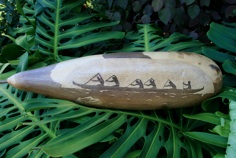IPU (GOURD) ART

Gourds have been used all over the planet for thousands of years. There are many ways to decorate them including painting, staining, carving, burning, and weaving onto them. In Hawai’i before the ships came, people of the island of Ni’ihau made decorated gourds (ipu) tools and calabashes for food, water, fish hooks, cordage storage, etc. These were traded to peoples of the other islands for items that this small island lacked. After the introduction of metal and ceramics, this art form ceased to be practiced, and indeed was a lost art form for 100 years. Dr Bruce Kamiola Chrisman, a local dermatologist, spent years rediscovering this art form.
The challenge was that all other methods of gourd decorating start with a dried gourd. The Hawai’ian Ni’ihau method starts with a living, growing ipu. It is picked when the stem turns brown. A design is drawn on it. Using a knife, the design lines are cut through the skin, but not into what will become the hard shell. Then the skin is removed from where the dye is NOT to go. After the newly exposed area dries, the ipu is opened and filled with dye. Coffee has been used for all brown ipu. The ipu is then left for 3 to 4 weeks with water being added daily. The rotten tissue is then thoroughly cleaned from the inside, and the remaining skin removed from the exterior. The top edge is now cut to the desired finished edge. After drying for two weeks, shellac is used to seal the interior, and tung oil on the outer surface.
Ms Whitehawk also creates finished ipu with various other methods, some of which may be viewed in the last photos.
Hawai’ian Ni’hau Method
